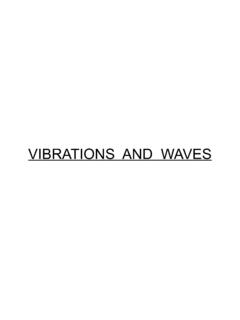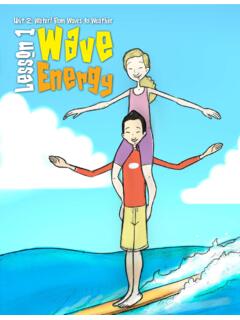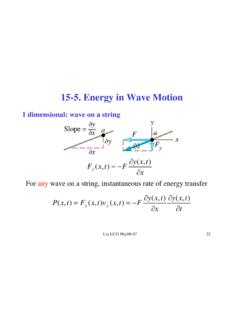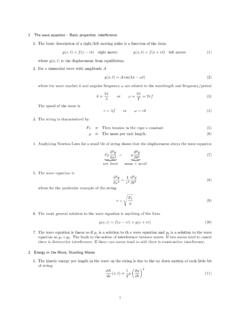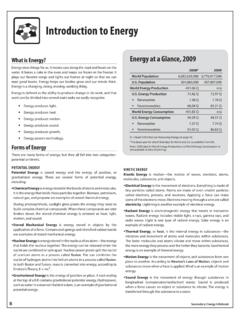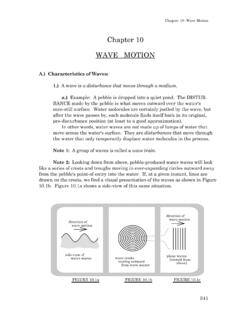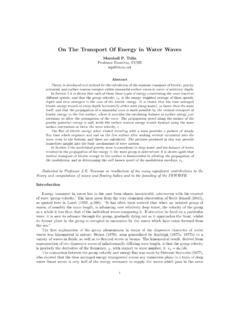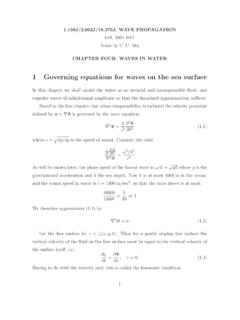Transcription of Wave Motion - Miami University
1 Wave MotionChapter 16 deals with the general properties of waves . We will be consideringseveral different types of waves ; however, here we ll concentrate on thosecharacteristics that are common to all :What is a Wave?Consider waves on a pondGeneral Definition of a Wave: A wave is an organized disturbance that travels at a well defined speed Note: the disturbance propagates, the medium (if there is one) has nobulk Motion . (The medium can oscillate, but it doesn t move with the wave.)Also, waves are very different than particles which are localized ( theyexist at a point). waves are spread out in space, but they do share afeature with particles: waves carry energy and things move by travelling oscillations of WavesWe will consider three general types of waves :1.) Mechanical waves Require a medium to propagate The wave speed is determined by the elastic properties and inertia of the medium Oscillations can be transverse or longitudinal to the wave direction Videoof mechanical waves (be honest, is this video too boring?
2 Examples: wave on a string (PhET), sound waves (PhET), water waves (Dr Beerplaying on a wave last summer), stadium wave(?).2.) Electromagnetic waves Requires no medium to propagate (.. interesting) Disturbances in the electromagnetic fields that travel in vacuum at the speed of light, c = 3 X 108m/s. visible light, radio waves , x-rays, etc. 3.) Matter waves At the level of fundamental particles, like electrons, particles have wave properties; This is Quantum Mechanics; What s doing the waving?2 Wave Speed for a StringConsider a transverse wave pulse on a string:Equilibrium position of the stringPheTAs derived in your text, the speed of the wave is:Where:PheT3 Whiteboard Problem 16-1 The wave speed on a string is 150 m/s when the tension is 75N. What tension will give a speed of 180 m/s? (MP)4 Travelling Sinusoidal WaveA sinusoidal (or harmonic) disturbance creates a sinusoidal travelling a given time, this wave is a sine wave in space, and at a given point in space,a point has harmonic Motion in D(x,t) is the general disturbance from the equilibrium : it is a function of two variables.
3 PheT5 The Equation of Travelling Sinusoidal Wave Fundamental Relationfor waves General Equation of a sinusoidal travelling wave:Travelling in +x directionTravelling in -x direction(watch the k s !)6 One Other Thing About the Travelling Sinusoidal WaveRemember what we had for the simple harmonic oscillator:The differential equation:The solution:There s something similar for waves :The solution:The differential equation:7 Computer Activity:Expression for a Travelling WaveOn MP, start up the tutorial: Expression for a Travelling WaveAs you answer the questions, start up the PhETsimulation Wave on a String,and try to create and examine waves of different amplitude, frequency, sure that you have No End selected and turn the damping to None . Problem 16-2 The displacement of a wave traveling in the positive x direction isD(x,t) = ( cm) sin ( 124t)where x is in meters and t is in seconds.
4 What are thea)frequency? (MP)b)wavelength? (MP)c)speed of the wave? (MP)d)displacement D at x = and t = (MP)9 Whiteboard Problem 16-3 Find an expression for the displacement for a sinusoidal wave asa function of y and t. The wave is traveling in the negative y-direction with a wavelength of 50 cm, speed of m/s, and an amplitude cm. (MP)(assume the phase constant is zero.) 10 waves in 2 and 3 DimensionsWave frontsIn 2D or 3D, the amplitude of the wave will decrease since the energy isspread out over a larger circle (in 2D) or a sphere (in 3D). So a sinusoidal wavelooks like:SourceNote: this is for an outgoing on a pond PhaseFor any sinusoidal wave ( 1D):The wave phase determines where you are on the wave, a peak, zero,trough, or somewhere in chapter 17, we ll look at combining waves , and the difference inphase will be very Difference Between Two Points at the Same a 1D single wave travelling to the right at some time t:Phase difference between points 1 and 2 at time t:(1 full cycle)(1/2 cycle)13 Whiteboard Problem 16-4A spherical wave with a wavelength of m is emitted fromthe origin.
5 At one instant of time, the phase at r1= m this same time, what is the phase ata)r2= m? (MP)b)r3= m? (MP)14
